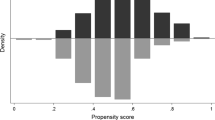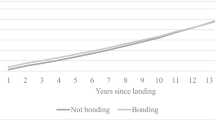
Overview
- Provides an original and timely contribution to the literature about the effects of US immigration policy and the economic status of Asian immigrants
- Proposes a richer model for studying immigrant earnings that incorporates investments in human capital by immigrants and their families
- Provides a primer on how to study immigrant economic assimilation
Access this book
Tax calculation will be finalised at checkout
Other ways to access
About this book
In 1965, a family-reunification policy for admitting immigrants to the United States replaced a system that chose immigrants based on their national origin. With this change, a 40-year hiatus in Asian immigration ended. Today, over three-quarters of US immigrants originate from Asia and Latin America. Two issues that dominate discussions of US immigration policy are the progress of post-reform immigrants and their contributions to the US economy.
This book focuses on the earnings and human capital investment of Asian immigrants to the US after 1965. In addition, it provides a primer on studying immigrant economic assimilation, by explaining economists’ methodology to measure immigrant earnings growth and the challenges with this approach. The book also illustrates strategies to more fully use census data such as how to measure family income and how to use “panel data” that is embedded in the census.
The book is a historical study as well as an extremely timely work froma policy angle. The passage of the 1965 Immigration and Nationality Act set the United States apart among economically developed countries due to the weight given to family unification. Based on analyses by economists—which suggest that the quality of immigrants to the US fell after the 1965 law—policymakers have called for fundamental changes in the US system to align it with the immigration systems of other countries. This book offers an alternative view point by proposing a richer model that incorporates investments in human capital by immigrants and their families. It challenges the conventional model in three ways: First, it views the decline in immigrants’ entry earnings after 1965 as due to investment in human capital, not to permanently lower “quality.” Second, it adds human capital investment and earnings growth after entry to the model. And finally, by taking investments by family members into account, it challenges the policy recommendation that immigrants should be selected for their occupational qualifications rather than family connections.Similar content being viewed by others
Keywords
Table of contents (23 chapters)
-
Front Matter
-
Part II
-
Front Matter
-
-
Part III
-
Front Matter
-
Reviews
“Human Capital Investment exposes the substantial upward mobility of U.S. immigrants from Asia. Through meticulous data analysis, the authors reveal robust earnings growth for Asian immigrants and refugees by including initial earnings and those who are not working, in school and self-employed. These findings -- together with those presented in a new volume of the Annals of the American Academy of Political and Social Science: Refugee and Immigrant Integration: The Promise of Local Action (July 2020) -- have much to offer to scholars and policy makers seriously concerned about immigrant and refugee integration.” (Katharine M. Donato, Donald G. Herzberg Professor of International Migration, and Director of the Institute for the Study of International Migration, at Georgetown University's Walsh School of Foreign Service)
Authors and Affiliations
About the authors
Harriet Duleep is Research Professor of Public Policy at the College of William and Mary, USA. She is also a Research Fellow at the Institute for the Study of Labor and the Global Labour Organization.
Mark C. Regets is Senior Fellow at the National Foundation for American Policy, USA. He is also a Research Fellow at the Institute for Labor Economics and the Global Labour Organization.
Seth Sanders is Professor of Economics at Cornell University, USA. He is also a Research Fellow at the Institute for the Study of Labor. He was previously the Director of the Duke University Population Research Center.
Phanindra V. Wunnava is David K. Smith '42 Chair in Applied Economics at Middlebury College, USA. He is also a Research Fellow at the Institute for the Study of Labor and the Global Labour Organization.Bibliographic Information
Book Title: Human Capital Investment
Book Subtitle: A History of Asian Immigrants and Their Family Ties
Authors: Harriet Duleep, Mark C. Regets, Seth Sanders, Phanindra V. Wunnava
DOI: https://doi.org/10.1007/978-3-030-47083-8
Publisher: Palgrave Macmillan Cham
eBook Packages: Economics and Finance, Economics and Finance (R0)
Copyright Information: The Editor(s) (if applicable) and The Author(s), under exclusive license to Springer Nature Switzerland AG 2020
Hardcover ISBN: 978-3-030-47082-1Published: 11 February 2021
Softcover ISBN: 978-3-030-47085-2Published: 11 February 2022
eBook ISBN: 978-3-030-47083-8Published: 10 February 2021
Edition Number: 1
Number of Pages: XXVII, 270
Number of Illustrations: 6 b/w illustrations, 15 illustrations in colour
Topics: Labor Economics, Migration, Public Policy, Economic Theory/Quantitative Economics/Mathematical Methods, US History, Sociology of Work



